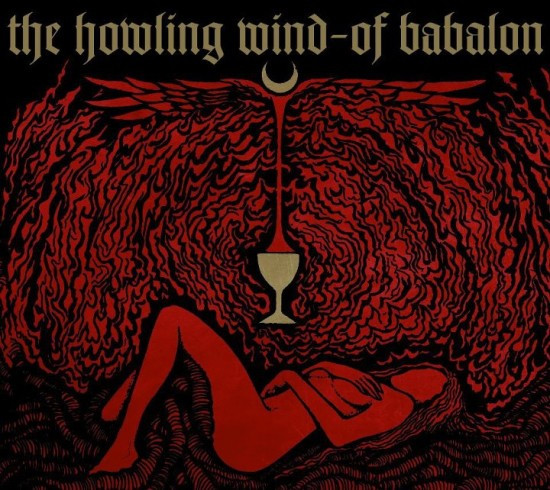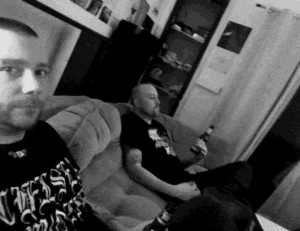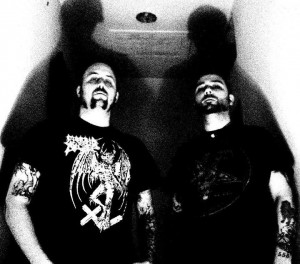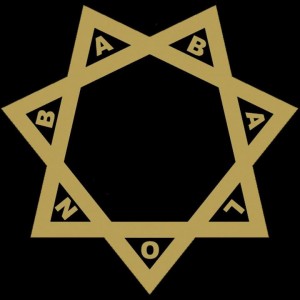
(In this post, our UK-based writer Andy Synn reviews the new album by the bi-coastal due known as The Howling Wind.)
“The Howling Wind?”, I hear you cry (somehow, from behind the dubious safety of my keyboard), “that sounds like some sort of black metal band to me!”.
Well shame on you for making an assumption based purely on the band’s name. How do you know they aren’t the latest leaders in progressive post-core, or the new face of technical instrudjental metal, hmm? For shame.
But you’re right. The Howling Wind are most definitely black metal. Of a particularly dark and forbidding kind. Of a particularly American kind, in fact.
The term “American black metal” has been thrown around a fair bit in recent years, often thoughtlessly so. Personally I think that while it is not a strict genre term (being applied rather widely as it is), there is a noticeable underlying style which links “American black metal” together – a cultural background and a certain form of approach to the style which is neurologically different from its European forebears.
Partially this is because American attempts at a pure emulation of the European style usually end up as hideous amalgams of cliché and misunderstanding (Averse Sefira and Martriden are, off the top of my head, two of the few bands whose style is particularly Trans-Atlantic), but equally black metal is often best as a representation of cultural roots. Not in a folk-style (though a good number of them utilise folk melodies and themes), but as an extrapolation of culture and its extremities. That’s why there’s a difference between the paragons of Swedish and Norwegian black metal, for example. Similar in style, vastly different in approach. And so the same holds true for American black metal, of which Of Babalon is a near perfect example.
 “The Seal Upon The Tomb” begins as a flickering candle of slowly building dissonance, whose black flame slowly blooms into an infectious miasma of charged, venomous dissonance. The grating, mid-tempo riffs and scorched, cracked vocals craft a murky atmosphere of ritualistic horror, while the drums switch back and forth between punkish downbeats and blackened hammering. The track’s scintillating solo skirts the edge of madness, while the caustic rhythm guitars marry bone-scraping harshness to a crippling sense of dread, culminating in a torrent of undulating riffage and another finger-bleeding solo.
“The Seal Upon The Tomb” begins as a flickering candle of slowly building dissonance, whose black flame slowly blooms into an infectious miasma of charged, venomous dissonance. The grating, mid-tempo riffs and scorched, cracked vocals craft a murky atmosphere of ritualistic horror, while the drums switch back and forth between punkish downbeats and blackened hammering. The track’s scintillating solo skirts the edge of madness, while the caustic rhythm guitars marry bone-scraping harshness to a crippling sense of dread, culminating in a torrent of undulating riffage and another finger-bleeding solo.
The track serves as a prime showcase for the progressive ambitions that underlie the album’s creation – folding in and swallowing all manner of external and esoteric influences into a sound that cannot but be described as black metal, yet with a cold, calculated intelligence that looks far beyond the constraints of the genres’ ancestral boundaries.
The lunatic “Beast Of The Sea” is a thunderous affair, a lurching Mastodonian heaviness draped in a shroud of unforgiving, blackened misanthropy. The vocals are utterly monstrous, moving from a banshee scream of anguish to a tyrannical growl of bowel-trembling ferocity. Dizzying, madcap tremolo runs trip and buffet the listener from all sides as the primitive, aggressive drumming batters at the senses, producing a hypnotic wall of dissonant aggression and formless crawling chaos.
“Graal” is another pitch-black attack of gnashing teeth and grinding bones, shot through with a dark thread of eerie melody, courtesy of the serpentine lead refrain that slices through the grim murk of the track’s roiling riffs and ceaseless snare-drum battery. There is brilliant use of bare, jagged chords during the song’s pseudo-chorus refrain, their bleached bone structure displayed in sharp contrast to the thick and moody sludge surrounding them. The drums remain defiantly aggressive throughout, rarely shifting from their punchy, blast-laden approach, anchoring the melodic digressions and subtle tempo shifts with their unflinchingly savage performance. The climax of the song comes in a dizzying whirlwind of ascending tremolo runs and intense, rising chord sequences, over which a schizophrenic solo weeps and wails.
“Scaling The Walls” alters the direction of the album almost without warning, delving into a Nachtmysium-esque pool of twisted harmony and sickly melodies which barely mask the fetid aura of decay that permeates the track. Yet from these squalid depths it rises like a mighty leviathan, all sinuous melodic coils and pulsing black muscle. There is something far more brutal, far more threatening, in the writhing contortions of the track’s second half than its early bars of seductive, hypnotic distortion could have prepared you for, the song’s structure moving from its darkly layered, trippy opening, to a terrifying finale of back-breaking seizures and frothing, rabid vocals.
 The perilous ascension of “The Mountain View” mirrors its subject in form and structure, building from creeping foothills of droning distortion and murky atmospherics to a pinnacle of glorious dissonance and stark, pitiless clarity. The early doom of its opening minutes soon gives way to a veritable avalanche of scalding tremolo parts and volcanic, blasting drums, over which the vocals spit venom and vitriol.
The perilous ascension of “The Mountain View” mirrors its subject in form and structure, building from creeping foothills of droning distortion and murky atmospherics to a pinnacle of glorious dissonance and stark, pitiless clarity. The early doom of its opening minutes soon gives way to a veritable avalanche of scalding tremolo parts and volcanic, blasting drums, over which the vocals spit venom and vitriol.
In tone and style the song reminds me of the best material from Satyricon’s Rebel Extravaganza – less mechanical and militaristic, but with a more brutish, gutter-punk attitude. Nowhere is this more apparent than in the interplay between the bruising, yet often stretched-taut, nature of the drumming (whose exhausting performance teeters precariously just this side of total collapse) and the varied, at times chaotic sequencing of blood-drunk, black-coated, and death-inflected riffage
The hideous noise and twisted death metal vibe of “Abominations and Filth” come at the listener like an unholy mix of early Entombed’s swaggering attitude and Deathspell Omega’s occult mesmerism. Ringing, organic tones smeared with blood and offal ring out behind the buzz-saw rage of the song’s stomping riffage, shot through with pulsing red veins of infected, malignant melody and oily, suppurating bass. The constantly shifting shape and chaotic, abstract mood of the piece conceal a cold and calculating intellect and a vast maw of progressive and trangressive ambition.
While often understated in their performance, the use of subtle drum accents adds a burning, virulent edge to the ripping riffs of “Choronzon”. The track mixes clattering punk-rock nihilism with moments of devastating death metal groove without ever losing its hard-won black metal identity, seamlessly integrating elements of these varied styles in a display of demonic symbiosis.
The track also provides a showcase for the distinctive riffing style of the band, which takes predictable patterns and progressions and tilts them on their axis, moving them through unholy dimensions in order to perceive them in a new light. The groaning, sky-splitting thunder of intertwining bass and drums provides the song with a crushing low-end rumble, juxtaposed against eye-searing flashes of electric melody courtesy of the scything tremolo guitars. The ragged vocals bleed with passion and loathing in equal amounts, while the track benefits hugely from the inclusion of a furious, technically adept solo, whose crippled majesty leads into a devastating ending of bulldozing groove and frantic lead guitars.
“Gateways”, the album’s true finale (disregarding the hidden cover track), begins with a painful birth, all agonising convulsions and crushing contractions, before slowly transforming into something more reverential. While it begins as a compelling display of howling insanity and rapturous, decadent bass-lines, it slowly unfolds into a stomping procession of broken chord-patterns and ringing, harmonic guitar lines which achieve a precarious balance between dark beauty and brooding malevolence. The razor-blade melodic notes that cut and scar across the blasted landscape of the song’s second half allow further insight into the unhinged intelligence behind the music, offering a unique take on black metal’s traditional blizzard of frostbitten power, hypnotising and disorienting the listener with their ever-shifting shapes and structures.
 Visceral and raw throughout, there is something quintessentially American about this album, a sense of character or identity that situates it in geography, if not in spirit. Related, loosely, at the genetic level to the frenetic riff-work and carefree artistry of Mastodon and High On Fire – two artists who similarly use a stripped down aesthetic to pursue a wholly individualistic take on their chosen genre – this is an album stripped of pretension, yet with a grand guiding vision of what it wishes to create.
Visceral and raw throughout, there is something quintessentially American about this album, a sense of character or identity that situates it in geography, if not in spirit. Related, loosely, at the genetic level to the frenetic riff-work and carefree artistry of Mastodon and High On Fire – two artists who similarly use a stripped down aesthetic to pursue a wholly individualistic take on their chosen genre – this is an album stripped of pretension, yet with a grand guiding vision of what it wishes to create.
Yet The Howling Wind are very much the black sheep of this family, a mutant strain or throwback to a darker age, choosing to follow their own haunted and terrible path. Swimming in waters where their brethren would not dare, in these blackened pools they have found a deeper kinship with those others who pursue the black arts, regardless of where they came from or where their obsession will take them.
That, to me, is the essence of American black metal, a kinship more of character and vision than of strict sound. And with Of Babalon The Howling Wind have produced an album that could well serve as a banner to rally all those with souls of black, no matter their origin, or the company they keep.
EDITOR’S NOTE: Of Babalon is out now on Profound Lore Records. The album’s striking cover art is by Tony Roberts. The Howling Wind are Ryan Lipynsky (Serpentine Path, ex-Unearthly Trance, ex-Thralldom) and Tim Call (Aldebaran, Weregoat). The band’s Facebook page can be found via this link.
There is indeed a ninth bonus track on the album. Although untitled in the promo file we received, it’s a cover of “Horus/Aggressor” by Hellhammer, which explains the change in vocal style that you’ll hear on the song.
Here are two tracks from Of Babalon — though, unexpectedly, at the time of this writing the entire album is still streaming at Invisible Oranges (here):

killer band!!!!! Need to get this record ASAP!!!! loved the two tracks!!!
Not half bad, I might just have to get this.
My work here is done.